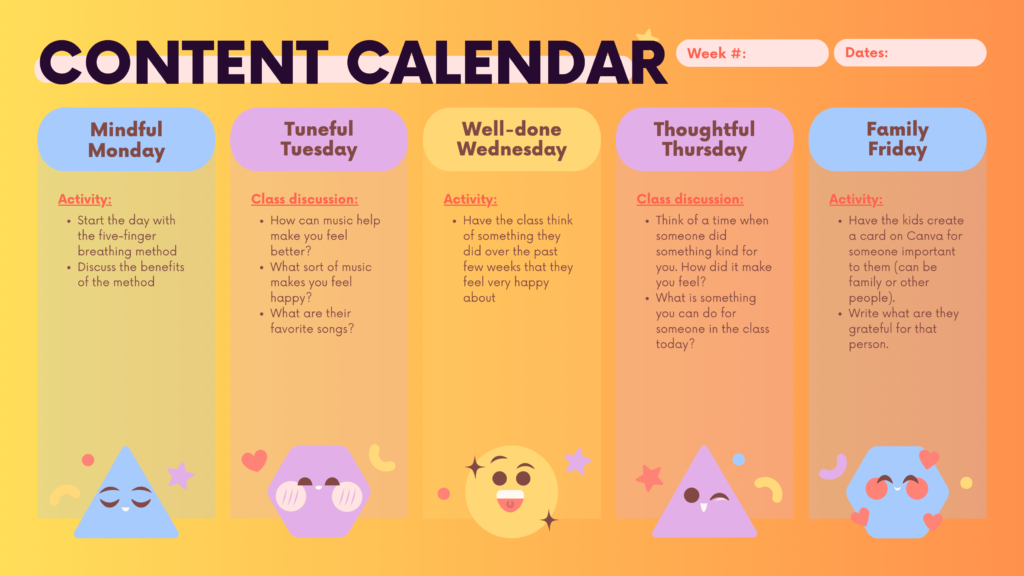Table of Contents
ToggleHow To Create A Content Calendar
How To Create A Content Calendar
How To Create A Content Calendar? Creating A Content Calendar Is Essential For Maintaining An Organized And Consistent Approach To Your Content Creation And Distribution Efforts. Whether You are Managing A Blog or Social Media Accounts Or Any Other Online Platform A Content Calendar Helps You Plan or Schedule And Track Your Content Effectively.
1. Define Your Goals And Objectives
Start By Clarifying Your Content Marketing Goals. Are You Aiming To Increase Brand Awareness or Drive Website Traffic or Engage With Your Audience Or Promote Specific Products-Services. Your Goals Will Shape The Type Of Content You Create.
2. Identify Your Target Audience
Understand Your Target Audience’s Preferences or Interests And Pain Points. Tailor Your Content To Resonate With Their Needs And Preferences.
3. Choose Content Themes And Topics
Brainstorm A List Of Content Themes And Topics That Align With Your Goals And Audience. Consider Educational or Informative or Entertaining And Promotional Content Ideas.
4. Determine Content Types
Decide On The Types Of Content You will Create or Such As Blog Posts or Videos or Infographics or Podcasts or Social Media Posts And More. Different Formats Cater To Different Audience Preferences.
5. Select Content Channels
Identify The Platforms Where You’ll Publish And Share Your Content. This Could Include Your Website or Blog or Social Media Platforms or Email Newsletters And More.
6. Set Frequency And Timing
Determine How Often You’ll Publish New Content And Establish A Consistent Posting Schedule. Consider Peak Times For Your Target Audience Online Activity.
7. Create A Content Calendar Template
Choose A Tool To Create Your Content Calendar. It Could Be A Spreadsheet or Project Management Software Or Specialized Content Calendar Tools.
8. Fill In Key Dates And Events
Add Important Dates or Holidays or Industry Events or Product Launches And Relevant Milestones To Your Calendar. These Will Serve As Anchor Points For Planning Content.
9. Plan Content Themes And Topics
Assign Specific Content Themes And Topics To Each Week Or Month. Ensure Variety And Balance In The Topics You Cover.
10. Develop Content Ideas
Under Each Theme Or Topic or Brainstorm Specific Content Ideas. These Could Be Detailed Outlines or Working Titles Or Descriptions Of The Content You Plan To Create.
11. Assign Responsibilities
If You’re Working With A Team Assign Responsibilities For Content Creation or Editing or Design And Promotion. Clearly Communicate Deadlines And Expectations.
12. Create A Production Timeline
Estimate The Time Needed For Each Content Piece or From Research And Creation To Editing And Finalization. Set Realistic Timelines To Avoid Rushing Or Missing Deadlines.
13. Schedule Publishing Dates
Determine The Specific Dates And Times When Each Piece Of Content Will Be Published Or Shared On Your Chosen Platforms.
14. Monitor And Track Performance
Regularly Review And Analyze The Performance Of Your Published Content. Measure Metrics Such As Engagement or Reach or Clicks And Conversions.
15. Adapt And Optimize
Based On Performance Data And Audience Feedback Make Necessary Adjustments To Your Content Calendar. Optimize Your Strategy For Better Results Over Time.
16. Content Creation And Workflow
Outline The Step By Step Process For Content Creation or Including Research or Drafting or Editing or Design And Finalization. Clearly Define Roles And Responsibilities For Each Stage To Ensure A Smooth Workflow.
17. Content Repurposing
Explore Opportunities To Repurpose And Recycle Existing Content. For Example- You Can Turn A Blog Post Into A Video or Create An Infographic From A Podcast Episode Or Share Snippets Of Long Form Content On Social Media.
18. SEO And Keywords
Incorporate Search Engine Optimization Into Your Content Calendar. Research Relevant Keywords And Phrases To Optimize Your Content For Better Visibility In Search Engine Results.
19. Evergreen Vs. Timely Content
Differentiate Between Evergreen Content (Timeless And Relevant) And Timely Content (Related To Current Events Or Trends). Balance Both Types To Maintain A Well Rounded Content Mix.
20. Guest Contributors And Collaborations
Consider Inviting Guest Contributors Or Collaborating With Industry Experts For Guest Posts or Interviews Or Co Created Content. This Adds Diversity And Fresh Perspectives To Your Calendar.
21. Content Promotion Strategy
Outline How You’ll Promote Each Piece Of Content Across Different Channels. Plan Social Media Posts or Email Newsletters And Other Distribution Methods To Maximize Reach.
22. Visual And Multimedia Elements
Integrate Visual Components Like Images or Graphics And Videos Into Your Content Calendar. Visual Content Enhances Engagement And Captures Your Audience Attention.
23. Analytics And Reporting
Dedicate Time To Analyzing The Performance Of Your Content. Use Tools Like Google Analytics or Social Media Insights And Email Marketing Metrics To Measure Effectiveness.
24. A/B Testing
Experiment With Different Content Formats or Headlines or Visuals And Posting Times. A/B Testing Helps You Identify What Resonates Best With Your Audience.
25. Content Themes And Campaigns
Plan Overarching Content Themes Or Campaigns That Align With Your Business Goals. These Could Span Across Weeks Or Months or Creating A Cohesive Narrative.
26. Social Media Calendar Integration
If Social Media Is A Key Distribution Channel or Integrate Your Social Media Posting Schedule Into Your Content Calendar. This Ensures Consistency Across Platforms.
27. Editorial Guidelines
Establish Editorial Guidelines For Tone, Style, Voice, And Branding. Consistency In Messaging And Aesthetics Reinforces Your Brand Identity.
28. Content Maintenance And Updates
Regularly Review And Update Evergreen Content To Ensure Its Relevance And Accuracy. This Prolongs The Lifespan Of Your Valuable Content Assets.
29. Seasonal And Trend-Based Content
Capitalize On Seasonal Trends, Holidays, And Industry Events By Planning Relevant Content In Advance. This Keeps Your Content Calendar Fresh And Aligned With Current Themes.
30. Feedback Loop And Improvement
Create A Process For Gathering Feedback From Your Audience or Team Members Or Stakeholders. Use This Input To Refine Your Content Strategy And Calendar Over Time.
A Comprehensive Content Calendar Serves As A Roadmap For Your Content Marketing Efforts or Enabling You To Strategically Plan or Create And Distribute Content That Resonates With Your Target Audience.
How To Create A Content Calendar,How To Create A Content Calendar,How To Create A Content Calendar
How To Create A Content Calendar,How To Create A Content Calendar,How To Create A Content CalendarHow To Create A Content Calendar,How To Create A Content Calendar,How To Create A Content CalendarHow To Create A Content Calendar,How To Create A Content Calendar,How To Create A Content Calendar,How To Create A Content Calendar,How To Create A Content Calendar,How To Create A Content CalendarHow To Create A Content Calendar,How To Create A Content Calendar,How To Create A Content Calendar

How To Create A Marketing Calendar
How To Create A Marketing Calendar
Creating A Marketing Calendar Is Essential For Organizing or Planning And Executing Your Marketing Activities Effectively.How To Create A Marketing Calendar . A Well Structured Marketing Calendar Helps You Stay On Track or Maintain Consistency And Align Your Efforts With Your Business Goals. Here’s A Step-By-Step Guide To Creating A Marketing Calendar:
1. Define Your Marketing Goals
Clearly Outline Your Marketing Objectives. Are You Aiming To Increase Brand Awareness or Boost Sales or Launch A New Product Or Engage With Your Audience. Your Goals Will Shape Your Marketing Strategies.
2. Identify Target Audience
Understand Your Target Audience’s Demographics or Preferences And Behaviors. Tailor Your Marketing Campaigns To Resonate With Their Needs And Interests.
3. Choose Marketing Channels
Determine The Marketing Channels You’ll Use To Reach Your Audience. This Could Include Social Media or Email Marketing or Content Marketing or Paid Advertising or Events And More.
4. Set Time Period
Decide On The Time Frame For Your Marketing Calendar. It Could Be A Monthly or Quarterly Or Yearly Calendar or Depending On Your Business’s Needs And Marketing Campaigns.
5. Select Calendar Tool
6. List Key Dates And Events
Add Important Dates or Holidays or Industry Events or Product Launches And Promotional Campaigns To Your Calendar. These Dates Will Anchor Your Marketing Planning.
7. Plan Campaign Themes
Define The Overarching Themes Or Focuses For Each Period. This Could Be Based On Seasonal Trends or Product Launches Or Specific Marketing Objectives.
8. Break Down Campaigns
Divide Your Campaigns Into Phases Or Steps. This Helps You Allocate Tasks or Resources And Deadlines More Efficiently.
9. Assign Responsibilities
Determine Who Is Responsible For Each Aspect Of The Campaign or Including Content Creation or Design or Advertising And Promotion. Clearly Communicate Roles And Expectations.
10. Develop Content And Creative Assets
Create A List Of Content or Visuals And Assets Needed For Each Campaign. This Could Include Blog Posts or Social Media Graphics or Email Templates or Videos And More.
11. Set Milestones And Deadlines
Establish Milestones And Deadlines For Each Phase Of The Campaign. This Ensures That Tasks Are Completed On Time And The Campaign Progresses Smoothly.
12. Allocate Budget
Allocate A Budget For Each Campaign or Including Advertising Costs or Design Expenses And Any Other Relevant Expenditures.
13. Integrate Social Media
If Social Media Is A Key Component Of Your Marketing Strategy or Integrate Your Social Media Posting Schedule Into Your Marketing Calendar. This Ensures Consistent Messaging Across Channels.
14. Monitor And Analyze
Regularly Track And Analyze The Performance Of Your Marketing Campaigns. Use Analytics Tools To Measure Key Metrics Such As Engagement or Conversion Rates And Return On Investment.
15. Review And Adapt
After Each Campaign or Conduct A Post Mortem Analysis To Evaluate What Worked Well And What Could Be Improved. Use These Insights To Refine Your Future Marketing Strategies.
16. Flexibility And Agility
While Planning Is Crucial Remain Flexible To Accommodate Unexpected Changes Or Opportunities That May Arise During The Execution Of Your Marketing Activities.
A Well Organized Marketing Calendar Empowers Your Team To Coordinate Efforts or Streamline Communication And Execute Campaigns With Precision. By Following These Steps And Maintaining A Proactive Approach To Planning And Execution You’ll Be Better Equipped To Achieve Your Marketing Objectives And Drive Business Growth.

How To Create A Social Media Calendar
How To Create A Social Media Calendar
Creating A Social Media Calendar Is Crucial For Maintaining A Consistent And Effective Presence On Social Platforms. It Helps You Plan or Schedule And Organize Your Social Media Content or Ensuring That You Engage Your Audience or Promote Your Brand And Achieve Your Marketing Goals. Here’s A Step By Step Guide To Creating A Social Media Calendar:
1. Define Your Social Media Goals
Clearly Outline Your Social Media Objectives. Are You Aiming To Increase Brand Awareness or Drive Website Traffic or Boost Engagement Or Promote Specific Products/Services . Your Goals Will Guide Your Content Strategy.
2. Identify Your Target Audience
Understand Your Target Audience’s Demographics or Interests or Behaviors And Preferred Social Platforms. Tailor Your Content To Resonate With Their Preferences.
3. Choose Social Media Platforms
4. Set Time Frame
Decide On The Time Frame For Your Social Media Calendar. It Could Be A Monthly or Weekly Or Even Daily Calendar or Depending On Your Content Volume And Posting Frequency.
5. Select A Social Media Calendar Tool
Choose A Tool To Create Your Social Media Calendar. You Can Use Spreadsheet Software Like Microsoft Excel Or Google Sheets or Social Media Scheduling Tools Or Project Management Software.
6. Outline Key Dates And Events
Add Important Dates or Holidays or Industry Events or Product Launches And Any Other Relevant Occasions To Your Calendar. These Dates Will Serve As Anchors For Your Content Planning.
7. Plan Content Themes And Campaigns
Define The Overarching Themes Or Focuses For Each Period. Align These Themes With Your Marketing Goals And Target Audience Interests.
8. Break Down Content Types
Determine The Types Of Content You’ll Create- Such As Blog Posts or Videos or Images or Infographics or Polls And Stories. Each Platform May Require A Different Content Format.
9. Allocate Content Ideas
Assign Specific Content Ideas To Each Day Or Week. Plan A Mix Of Promotional or Educational or Entertaining And Engaging Content To Keep Your Audience Interested.
10. Create Visual And Copy Assets
Develop The Necessary Visuals or Images or Videos or Captions And Hashtags For Each Post. Ensure That Your Content Aligns With Your Brands Visual Identity And Tone.
11. Set Posting Schedule
Determine The Optimal Posting Times For Each Platform Based On Your Audience’s Peak Activity. Use Social Media Insights Or Analytics Tools To Inform Your Schedule.
12. Pre-Schedule Posts
Use Social Media Scheduling Tools Like Buffer or Hootsuite Or Sprout Social To Pre Schedule Your Posts. This Ensures Consistent Posting Even If You’re Not Online.
13. Monitor And Engage
Regularly Monitor Your Social Media Channels For Comments or Messages And Mentions. Respond Promptly And Engage With Your Audience To Foster A Sense Of Community.
14. Analyze Performance
Track Key Metrics Such As Likes or Shares or Comments or Clicks And Conversions. Use Social Media Analytics To Evaluate The Success Of Your Content And Adjust Your Strategy Accordingly.
15. Review And Improve
After Each Period or Analyze Your Social Media Performance And Gather Insights. Identify What Worked Well And What Can Be Improved For Future Content Planning.
16. Stay Updated And Experiment
Keep Up With Social Media Trends And Algorithm Changes. Don’t Be Afraid To Experiment With New Content Formats or Hashtags And Strategies To Keep Your Audience Engaged.
17. Content Curation
Incorporate A Mix Of Original Content And Curated Content From Reputable Sources In Your Social Media Calendar. Curated Content Adds Value To Your Audience And Positions Your Brand As A Trusted Industry Resource.
18. User-Generated Content
Encourage Your Audience To Create And Share Content Related To Your Brand Or Products. Incorporate UGC Into Your Calendar To Showcase Authentic Interactions And Build A Sense Of Community.
19. Hashtag Strategy
Develop A Hashtag Strategy To Increase The Discoverability Of Your Content. Research Relevant And Trending Hashtags For Each Platform And Incorporate Them Into Your Posts.
20. Cross-Promotion
Plan Cross-Promotion Between Different Social Media Platforms. Promote Your Instagram Posts On Facebook or Share Youtube Videos On Twitter And Utilize Platform Specific Features Like Instagram Stories And Facebook Live.
21. Storytelling
Weave Storytelling Into Your Social Media Content. Share Narratives or Behind The Scenes Glimpses or Customer Success Stories Or Personal Anecdotes That Resonate With Your Audience.
22. Seasonal And Trendy Content
Plan Content Around Seasonal Events or Holidays And Trends. This Keeps Your Content Fresh or Relevant And Aligned With Current Happenings.
23. Content Recycling
Repurpose And Recycle Your Existing Content To Reach A Wider Audience. Turn Blog Posts Into Infographics or Break Down Long Videos Into Short Clips Or Share Throwback Posts To Highlight Evergreen Content.
24. Interactive Content
Incorporate Interactive Content Such As Polls or Quizzes or Challenges And Interactive Sessions. Engaging Content Encourages Audience Participation And Boosts Overall Engagement.
25. Collaborations And Takeovers
Collaborate With Influencers or Partners Or Employees For Social Media Takeovers. Let Them Create Content And Engage With Your Audience Introducing Fresh Perspectives.
26. Educational And How To Content
Share Educational And Informative Content That Addresses Your Audience’s Pain Points And Questions. How To Guides or Tutorials And Tips Establish Your Brand As An Authority In Your Industry.
27. Emotional Appeal
Craft Content That Resonates Emotionally With Your Audience. Share Inspirational Quotes or Personal Stories Or Content That Elicits Empathy And Connection.
28. Content Diversity
Ensure A Diverse Mix Of Content Formats or Such As Images or Videos or Carousels or Gifs And Live Videos. Cater To Different Preferences And Engagement Styles.
29. Monitor Competitors
Keep An Eye On Your Competitors’ Social Media Activities. Analyze Their Content Strategy And Identify Opportunities To Differentiate Your Brand Or Learn From Their Successes.
30. Agile Planning
While It’s Important To Have A Planned Calendar, Be Prepared To Adapt Quickly To Real Time Events or News Or Trends That Could Align With Your Brand.
31. Regular Review And Adjustment
Regularly Evaluate Your Social Media Calendar’s Performance. Use Analytics To Identify Top-Performing Content And Make Data-Driven Adjustments To Your Strategy.
A Well-Structured Social Media Calendar Empowers Your Brand To Engage or Connect And Grow Its Online Presence Strategically. By Incorporating A Variety Of Content Types or Themes And Engagement Strategies. You’ll Create A Dynamic And Compelling Social Media Strategy That Resonates With Your Target Audience And Supports Your Overall Marketing Objectives.
A Content Calendar Is A Document That Outlines Your Content Marketing Strategy For A Specific Period Of Time or Typically A Month Or A Quarter. It Includes The Topics You Plan To Cover or The Types Of Content You Plan To Create And The Dates You Plan To Publish Them.
Creating A Content Calendar Can Help You:
- Stay Organized And On Track With Your Content Marketing Efforts.
- Ensure You are Publishing A Variety Of Content That Appeals Your Target Audience.
- Optimize Your Content For Search Engines.
- Track The Performance Of Your Content And Make Necessary Adjustments.
Here Are The Steps On How To Create A Content Calendar
1. Define Your Goals
What Do You Want To Achieve With Your Content Marketing. Do You Want To Increase Brand Awareness or Generate Leads Or Drive Sales. Once You Know Your Goals You Can Tailor Your Content Calendar Accordingly.
2. Research Your Target Audience
Who Are You Trying To Reach With Your Content. What Are Their Interests? What Are Their Pain Points? Once You Know Your Target Audience You Can Create Content That They Will Find Valuable And Interesting.
3. Choose The Right Topics
What Topics Are You Passionate About? What Topics Do You Know A Lot About? What Topics Are Your Target Audience Interested In? Once You Choose Your Topics You Can Start Brainstorming Ideas For Content.
4. Plan Your Content Types
What Types Of Content Will You Create? Will You Write Blog Posts, Create Videos, Or Record Podcasts? Once You Know The Types Of Content You’ll Create, You Can Start Planning The Format And Length Of Each Piece Of Content.
5. Set A Publishing Schedule
How Often Will You Publish Content? Will You Publish Daily or Weekly Or Monthly? Once You Set Your Publishing Schedule, You Can Start Blocking Out Dates On Your Calendar For Each Piece Of Content.
6. Promote Your Content
Once You Publish Your Content, You Need To Promote It So That People Will See It. You Can Promote Your Content On Social Media or Email Marketing Or Guest Blogging.
7. Track Your Results
How Well Is Your Content Performing? Are You Reaching Your Target Audience? Are You Achieving Your Goals? You Can Track The Performance Of Your Content Using Analytics Tools Like Google Analytics Or Social Media Analytics Tools.
Here Are Some Additional Tips For Creating A Content Calendar
- Be Flexible
Things Don’t Always Go According To Plan or So Be Prepared To Make Adjustments To Your Content Calendar As Needed.
- Get Feedback
Ask For Feedback From Your Team or Your Target Audience, Or Experts In Your Field. This Feedback Can Help You Improve Your Content Calendar And Make Sure It’s Effective.
- Experiment
Don’t Be Afraid To Experiment With Different Types Of Content And Publishing Schedules. The Best Way To Find Out What Works Is To Try Different Things.
- Use A Content Calendar Template
There Are Many Content Calendar Templates Available Online That You Can Use To Get Started. These Templates Can Help You Stay Organized And On Track.
- Automate Your Content Calendar
If You Have A Large Volume Of Content To Publish. You May Want To Consider Automating Your Content Calendar. This Can Save You Time And Ensure That Your Content Is Published On Time.
- Use A Content Management System
A CMS Can Help You Organize Your Content And Make It Easier To Publish. There Are Many Cmss Available or Such As WordPress or Drupal And Joomla.
- Use A Project Management Tool
A Project Management Tool Can Help You Track The Progress Of Your Content Calendar And Make Sure That Everything Is On Track. There Are Many Project Management Tools Available or Such As Trello or Asana And Jira.
- Use Analytics To Track Your Results
Analytics Can Help You Track The Performance Of Your Content And Make Sure It’s Effective. There Are Many Analytics Tools Available or Such As Google Analytics And Adobe Analytics.
More..
https://mdzaka.com/
https://mdzaka.com/what-is-pillar-page-types-of-pillar-pages-creating-an-effective-pillar-page/
Creating a Successful Digital Marketing Strategy, What is Marketing Strategy 2025
https://mdzaka.com/learn-about-leads-what-leads-are-how-much-is-it-important-for-businesses/
How to Create a Best Landing Page 2025
What Are The Qualities Required To Become A Blogger
Remote Work,Remote Working Work From Home 2025
How to Create Strong Brand Online in Digital Marketing 2024
https://mdzaka.com/video-marketing/
Remote Work,Remote Working Work From Home 2025
https://mdzaka.com/artificial-intelligence-ai-vertex-ai-generative-ai/











